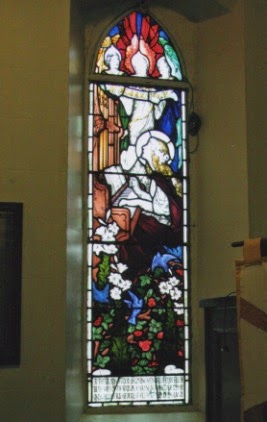The Jenks and Todd Show
Rappahannock County, Trinity Church, and Jenks in 1973
By Todd Endo
Jenks preached his first sermon at Trinity Church on July 1st in1973. That was a long time ago. Jenks has changed since then. Trinity Church has changed as well. The town of Washington has changed. Rappahannock County has changed. What were all of these like in 1973? Jenks remembers....
When Jenks arrived in 1973, the 211 bypass had just been completed. Prior to that, 211 came up Middle Street, entered a sweeping curve at the intersection with Main Street with a blinking red light warning signal, and continued out of town on Main Street. He remembers folks telling him that before the bypass there was a lot more street noise, especially caused by traffic and even buses on Middle and Main Streets, many bringing skiers to the nearby ski slope in Harris Hollow.
Merrill Ford and Esso, once one of the oldest Ford dealerships in the country, occupied what is now the Post Office and the Country Cafe. Its showroom windows are now those of the Country Cafe. Merrill Ford began on the site now occupied by the Inn. After Merrill moved, what were to become the Inn buildings became an antique shop. In 1978, The Inn began as a small restaurant and grew into it present mega status. Jenks say that “despite occasional ruffled feathers over parking issues, they have been good neighbors on many counts and continue to pay their monthly parking rent right on time.”
Clopton House, Jenks recalls, was a private low income apartment building with five units. The church parking lot was part old concrete floor, part potholed gravel, purchased about 1962 and cleared of buildings at that time. The church bought the Quiet Place prior to Jenks' arrival and tore down the buildings on it, which had been in disrepair and “were rumored to house ladies 'of ill repute.'” Trinity House was owned by Reed Payne and then later by Roger Batchelder. Mountainside Market, later moved to Sperryville, began there. In 1999, Trinity bought it and renovated it to its current uses. The Rappahannock Medical Center was built about 1974.
In 1973, the population of Rappahannock was at its lowest ebb in the 20th century—about 5200 people by the 1970 census. The general layout of the town of Washington was about the same as now, but there were more empty and run-down buildings. He remembers more drinking and driving, racing through the town at night. There were more children living in town then. He vividly recalls stories about the town telephone operators, Alice Verner and her daughters, prior to automatic dialing. “The daughters had made the switchboard the proverbial gossip center and source of much useful information, such as which young lady already had a date, so no use to call!”
The current physical Trinity Church remains pretty much as it was in 1973. Built in 1857 with the bell tower/vestibule added about 1900, all of it was stuccoed in the 20's. The Parish Hall was built in 1957 and was twenty feet shorter until its expansion in 1985. The Dried Flower Sale & House Tour was begun to pay off the mortgage on the original hall.
A dominant force in the church when Jenks arrived was Emily Miller, seemingly in charge of everything, although she held no official position in the church. She lived on the phone, she knew everything, she knew everybody. She helped Jenks begin his process of understanding who was here, who was who, and who was kin to whom. He had a standing invitation to have lunch with her, and went once or twice a week so that she could tell him what he needed to know about who was in the hospital and such.
When Jenks arrived in 1973, Trinity had one service on Sunday, attended by an average of about 35 worshippers. Most of them, Jenks quipped were either named Miller or kin to them. Low church Virginia Morning Prayer was the dominant liturgy, with communion once a month. The 8:00 communion service began in 1974, as soon as Jenks was ordained priest. He recalls that the service rarely had more than five worshippers in the 1970s, often none. Many of these were weekenders. Jenks remembers that the growth of families with children began shortly before he arrived and continued during his early years at Trinity. The 9:15 service was added in 1994 to accommodate that continued growth. Along the way the liturgical practice of Trinity has evolved into a rich variety of expression.
Jenks says that his path to Trinity was pretty direct, although not foreordained. He tells some of this story in his “From the Rector’s Desk” column in this issue of the Trinity Times. I will conclude this segment with Jenks’ decision to choose Trinity Rappahannock over Trinity Arlington where he had done his seminary internship. Jenks says that he “was proudly country and ready to return after 11 years of educational time in the city. This Trinity was a clear choice!” We are happy that he did!









